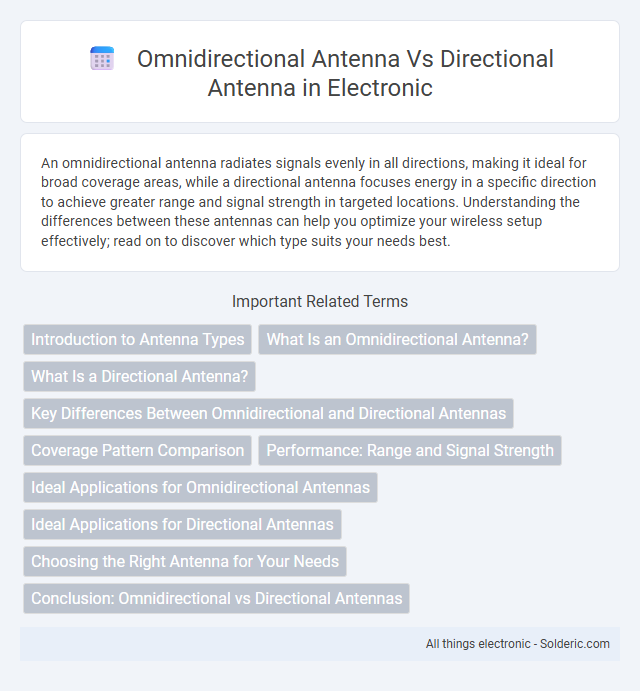An omnidirectional antenna radiates signals evenly in all directions, making it ideal for broad coverage areas, while a directional antenna focuses energy in a specific direction to achieve greater range and signal strength in targeted locations. Understanding the differences between these antennas can help you optimize your wireless setup effectively; read on to discover which type suits your needs best.
Comparison Table
| Feature | Omnidirectional Antenna | Directional Antenna |
|---|---|---|
| Signal Coverage | 360deg horizontal coverage | Focused signal in a specific direction |
| Use Case | Broad area coverage, Wi-Fi hotspots | Long-distance links, point-to-point communication |
| Gain | Lower gain (typically 2-5 dBi) | Higher gain (up to 15 dBi or more) |
| Range | Shorter effective range | Extended effective range |
| Installation | Simple, no precise aiming required | Requires precise alignment |
| Interference | More susceptible to interference from all directions | Less interference due to focused beam |
| Typical Applications | Wi-Fi routers, mobile devices, broadcasting | Wireless backhaul, satellite communication, radar |
Introduction to Antenna Types
Omnidirectional antennas transmit and receive signals in all horizontal directions, ensuring broad coverage for devices like Wi-Fi routers and mobile networks. Directional antennas focus their energy in a specific direction, providing stronger signals and longer range ideal for point-to-point communication and targeted coverage areas. Choosing the right antenna type enhances your network's efficiency and signal quality based on your coverage needs.
What Is an Omnidirectional Antenna?
An omnidirectional antenna radiates and receives signals equally in all horizontal directions, providing 360-degree coverage ideal for environments requiring broad signal distribution. Commonly used in Wi-Fi routers and cellular base stations, these antennas support mobile devices moving freely without signal dropouts. Unlike directional antennas that focus energy in a specific direction for long-range communication, omnidirectional antennas optimize local area network performance and signal consistency.
What Is a Directional Antenna?
A directional antenna focuses its signal transmission and reception in a specific direction, enhancing range and signal strength compared to omnidirectional antennas that radiate signals uniformly in all directions. This focused beam helps reduce interference and increase communication efficiency, making directional antennas ideal for point-to-point links or targeting specific areas. Choosing a directional antenna can improve Your network's performance when aiming for long-distance communication or minimizing signal loss.
Key Differences Between Omnidirectional and Directional Antennas
Omnidirectional antennas radiate signals uniformly in all directions, providing 360-degree coverage suitable for broad communication needs, while directional antennas focus energy in a specific direction, enhancing signal strength and range in targeted areas. Omnidirectional antennas are ideal for environments where You need consistent connectivity across multiple directions, whereas directional antennas excel in point-to-point links or long-distance communication. Key differences include radiation pattern, gain, range, and application scenarios, influencing antenna selection based on Your coverage and performance requirements.
Coverage Pattern Comparison
Omnidirectional antennas provide a 360-degree horizontal coverage pattern, ideal for broadcasting signals evenly in all directions, making them suitable for environments requiring widespread signal distribution. Directional antennas focus the signal in a specific direction, delivering higher gain and longer range within a narrower beamwidth, thus enhancing performance in targeted communication scenarios. The coverage pattern of omnidirectional antennas enables broad area connectivity, while directional antennas optimize signal strength and reduce interference by concentrating energy toward desired receivers.
Performance: Range and Signal Strength
Omnidirectional antennas provide 360-degree coverage, offering consistent signal strength over shorter distances, ideal for environments requiring broad area connectivity. Directional antennas concentrate energy in a specific direction, significantly enhancing range and signal strength, making them suitable for long-distance communication and targeted coverage. Performance depends on use case: omnidirectional excels in local coverage, while directional antennas maximize signal range and strength for focused links.
Ideal Applications for Omnidirectional Antennas
Omnidirectional antennas excel in environments requiring 360-degree coverage, such as wireless networks in urban areas, public Wi-Fi hotspots, and mobile communication systems. They are ideal for applications where signals must be broadcast uniformly in all directions to reach multiple devices, including smart home systems and IoT networks. Your setup benefits from omnidirectional antennas when broad coverage without precise targeting is essential.
Ideal Applications for Directional Antennas
Directional antennas excel in applications requiring focused signal transmission or reception over long distances, such as point-to-point communication links, satellite communication, and wireless backhaul networks. Their high gain and narrow beamwidth make them ideal for targeting specific locations, reducing interference from unwanted sources and improving signal quality in complex environments. Industries like telecommunications, broadcasting, and radar systems benefit significantly from directional antennas to enhance performance and signal reliability.
Choosing the Right Antenna for Your Needs
Selecting the appropriate antenna depends on your coverage and performance requirements; omnidirectional antennas provide 360-degree signal distribution ideal for broad area coverage and mobile connectivity, while directional antennas focus signal strength in a specific direction to achieve longer range and higher gain. For applications like Wi-Fi hotspots, cellular base stations, or environments requiring coverage around a central point, omnidirectional antennas optimize signal distribution. Directional antennas are preferred in point-to-point communication, long-distance links, or interference-prone environments to maximize signal quality and reduce noise.
Conclusion: Omnidirectional vs Directional Antennas
Omnidirectional antennas provide 360-degree coverage, making them ideal for environments where signals need to reach multiple directions simultaneously. Directional antennas concentrate energy in a specific direction, resulting in longer range and reduced interference, which is beneficial for targeted communication. Consider your coverage needs and signal focus when choosing your antenna to optimize network performance.
omnidirectional antenna vs directional antenna Infographic

 solderic.com
solderic.com